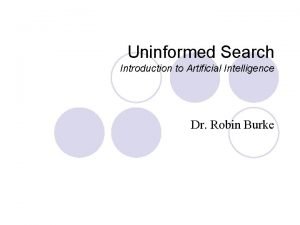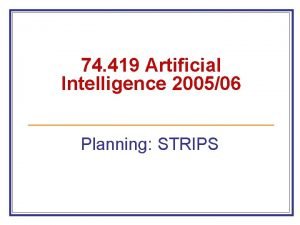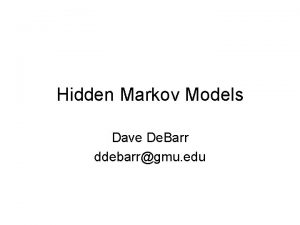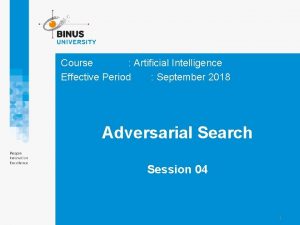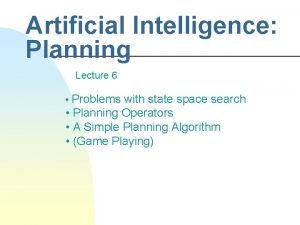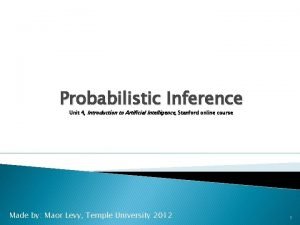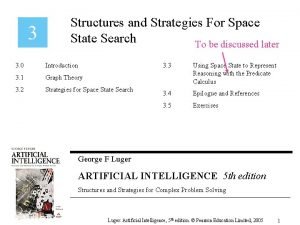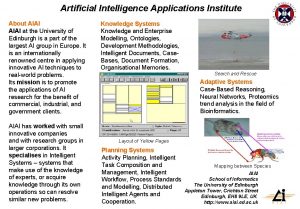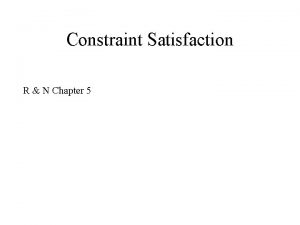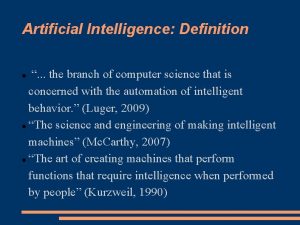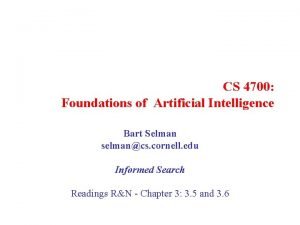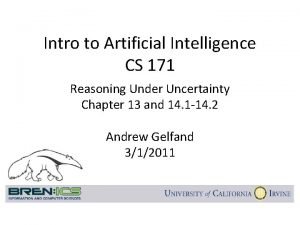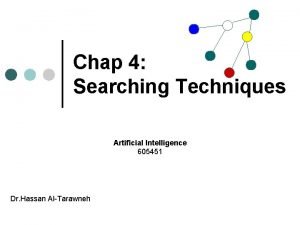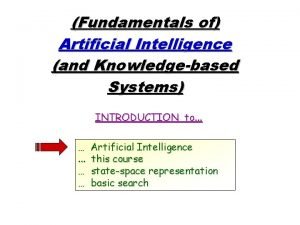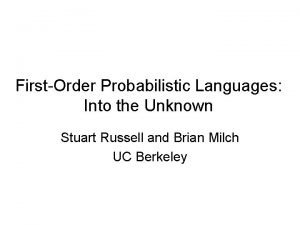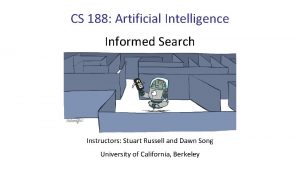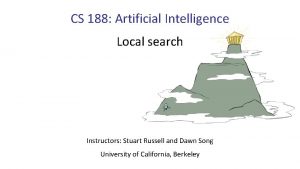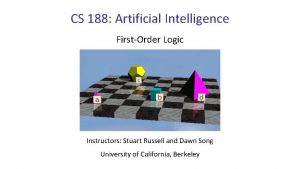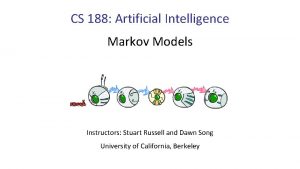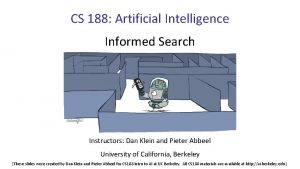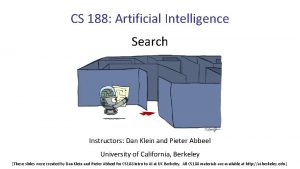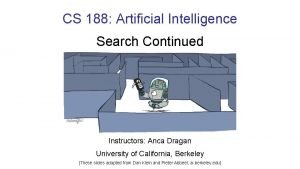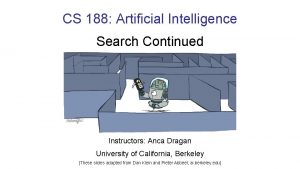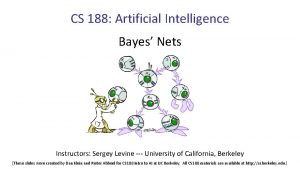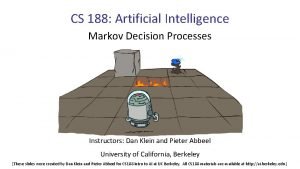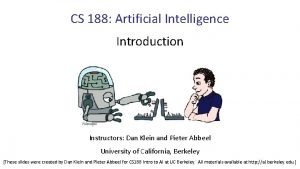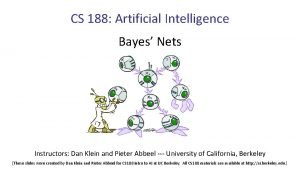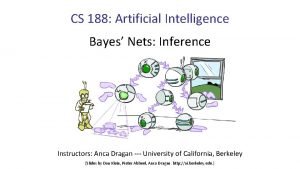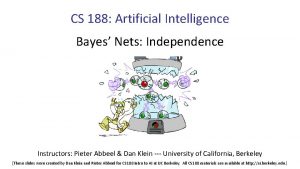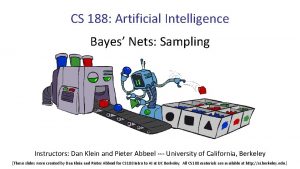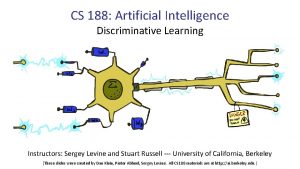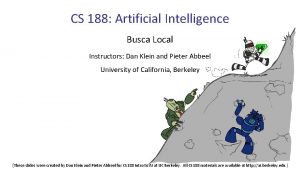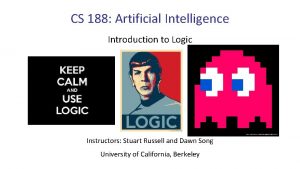CS 188 Artificial Intelligence Search Instructors Stuart Russell












































- Slides: 44

CS 188: Artificial Intelligence Search Instructors: Stuart Russell and Dawn Song University of California, Berkeley [slides adapted from Dan Klein, Pieter Abbeel]

Today § Agents that Plan Ahead § Search Problems § Uninformed Search Methods § Depth-First Search § Breadth-First Search § Uniform-Cost Search

Planning Agents § Planning agents decide based on evaluating future action sequences § Must have a model of how the world evolves in response to actions § Usually have a definite goal § Optimal: Achieve goal at least cost

Move to nearest dot and eat it

Precompute optimal plan, execute it

Search Problems

Search Problems § A search problem consists of: § § § A state space S An initial state s 0 Actions A(s) in each state Transition model Result(s, a) A goal test G(s) N -9 E -9 § S has no dots left § Action cost c(s, a, s’) § +1 per step; -10 food; -500 win; +500 die; -200 eat ghost § A solution is an action sequence that reaches a goal state § An optimal solution has least cost among all solutions

Search Problems Are Models

Example: Traveling in Romania

But then…

Example: Traveling in Romania § State space: § Cities § Initial state: § Arad § Actions: § Go to adjacent city § Transition model: § Reach adjacent city § Goal test: § s = Bucharest? § Action cost: § Road distance from s to s’ § Solution?

Models are almost always wrong

State Space Sizes § World state: § § Agent positions: 120 Food count: 30 Ghost positions: 12 Agent facing: NSEW § How many § World states? 120 x(230)x(122)x 4 § States for pathing? 120 § States for eat-all-dots? 120 x(230)

State Space Graphs and Search Trees

State Space Graphs E E § State space graph: A mathematical representation of a search problem § Nodes are (abstracted) world configurations § Arcs represent transitions (labeled with actions) § The goal test is a set of goal nodes (maybe only one) § In a state space graph, each state occurs only once! § We can rarely build this full graph in memory (it’s too big), but it’s a useful idea W E E S S N N N E S N N E W N E E E W W N S

State Space Graphs § State space graph: A mathematical representation of a search problem G a c b § Nodes are (abstracted) world configurations § Arcs represent successors (action results) § The goal test is a set of goal nodes (maybe only one) e d f S § In a state space graph, each state occurs only once! § We can rarely build this full graph in memory (it’s too big), but it’s a useful idea h p q Tiny state space graph for a tiny search problem r

State Space Graphs vs. Search Trees State Space Graph G a Each NODE in in the search tree is an entire PATH in the state space graph. c b e d S f h p q r We construct the tree on demand – and we construct as little as possible. Search Tree S e d b c a a e h p q q c a p h r p f q G q r q f c a G

Quiz: State Space Graphs vs. Search Trees Consider this 4 -state graph: a G S b How big is its search tree (from S)?

Quiz: State Space Graphs vs. Search Trees Consider this 4 -state graph: How big is its search tree (from S)? s a a G S b b a … b G a G b G G … Important: Those who don’t know history are doomed to repeat it!

Quiz: State Space Graphs vs. Search Trees Consider a rectangular grid: How many states within d steps of start? How many states in search tree of depth d?

Tree Search

Search Example: Romania

Creating the search tree frontier

Creating the search tree expanded frontier

Creating the search tree expanded frontier

General Tree Search § Main variations: § Which leaf node to expand next § Whether to check for repeated states § Data structures for frontier, expanded nodes

Depth-First Search

Depth-First Search Strategy: expand a deepest node first G a c b Implementation: Frontier is a LIFO stack e d S f h p r q S e d b c a a h e h p q q c a r p f q G p q r q f c a G

Search Algorithm Properties

Search Algorithm Properties § § Complete: Guaranteed to find a solution if one exists? Optimal: Guaranteed to find the least cost path? Time complexity? Space complexity? … § Cartoon of search tree: § b is the branching factor § m is the maximum depth § solutions at various depths b 1 node b nodes b 2 nodes m tiers bm nodes § Number of nodes in entire tree? § 1 + b 2 + …. bm = O(bm)

Depth-First Search (DFS) Properties § What nodes does DFS expand? § Some left prefix of the tree down to depth m. § Could process the whole tree! § If m is finite, takes time O(bm) § How much space does the frontier take? … b 1 node b nodes b 2 nodes m tiers § Only has siblings on path to root, so O(bm) § Is it complete? § m could be infinite § preventing cycles may help (more later) § Is it optimal? § No, it finds the “leftmost” solution, regardless of depth or cost bm nodes

Breadth-First Search

Breadth-First Search Strategy: expand a shallowest node first G a c b Implementation: Frontier is a FIFO queue e d S f h p r q S e d Search Tiers b c a a e h p q q c a h r p f q G p q r q f c a G

Breadth-First Search (BFS) Properties § What nodes does BFS expand? § Processes all nodes above shallowest solution § Let depth of shallowest solution be s s tiers § Search takes time O(bs) § How much space does the frontier take? … b 1 node b nodes b 2 nodes bs nodes § Has roughly the last tier, so O(bs) § Is it complete? § s must be finite if a solution exists, so yes! § Is it optimal? § If costs are equal (e. g. , 1) bm nodes

Quiz: DFS vs BFS

Quiz: DFS vs BFS § When will BFS outperform DFS? § When will DFS outperform BFS? [Demo: dfs/bfs maze water (L 2 D 6)]

Example: Maze Water DFS/BFS (part 1)

Example: Maze Water DFS/BFS (part 2)

Iterative Deepening § Idea: get DFS’s space advantage with BFS’s time / shallow-solution advantages § Run a DFS with depth limit 1. If no solution… § Run a DFS with depth limit 2. If no solution… § Run a DFS with depth limit 3. …. . § Isn’t that wastefully redundant? § Generally most work happens in the lowest level searched, so not so bad! … b

Uniform Cost Search

Uniform Cost Search 2 g(n) = cost from root to n b Strategy: expand lowest g(n) d S 1 c 8 1 3 Frontier is a priority queue sorted by g(n) G a 2 9 p 15 2 e 8 h f 2 1 r q S 0 Cost contours b 4 c a 6 a h 17 r 11 e 5 11 p 9 e 3 d h 13 r 7 p f 8 q q q 11 c a G 10 q f c a G p 1 q 16

Uniform Cost Search (UCS) Properties § What nodes does UCS expand? § Processes all nodes with cost less than cheapest solution! § If that solution costs C* and arcs cost at least , then the “effective depth” is roughly C*/ “tiers” C*/ § Takes time O(b ) (exponential in effective depth) § How much space does the frontier take? § Has roughly the last tier, so O(b. C*/ ) § Is it complete? § Assuming C* is finite and > 0, yes! § Is it optimal? § Yes! (Proof next lecture via A*) b … g 1 g 2 g 3

Video of Demo Maze with Deep/Shallow Water --- BFS or UCS? (part 1)

Video of Demo Maze with Deep/Shallow Water --- BFS or UCS? (part 2)
 Informed search and uninformed search
Informed search and uninformed search Which search strategy is also called as blind search?
Which search strategy is also called as blind search? Uninformed search in artificial intelligence
Uninformed search in artificial intelligence Iterative deepening search prolog
Iterative deepening search prolog Dr stuart russell
Dr stuart russell Edgar dale's cone of experience
Edgar dale's cone of experience Artificial intelligence devices
Artificial intelligence devices Inference in first order logic in artificial intelligence
Inference in first order logic in artificial intelligence Starts new page numbered sequentially
Starts new page numbered sequentially Introduction to artificial intelligence and expert systems
Introduction to artificial intelligence and expert systems Cpsc 322: introduction to artificial intelligence
Cpsc 322: introduction to artificial intelligence Omniscience in artificial intelligence
Omniscience in artificial intelligence Strips planning in artificial intelligence
Strips planning in artificial intelligence 15-780 graduate artificial intelligence
15-780 graduate artificial intelligence Artificial intelligence chapter 1
Artificial intelligence chapter 1 Artificial intelligence applications institute
Artificial intelligence applications institute Part picking robot peas
Part picking robot peas Artificial intelligence: a modern approach
Artificial intelligence: a modern approach Optimal decisions in games in artificial intelligence
Optimal decisions in games in artificial intelligence Planning in artificial intelligence
Planning in artificial intelligence 15-780 graduate artificial intelligence
15-780 graduate artificial intelligence Inference by enumeration in artificial intelligence
Inference by enumeration in artificial intelligence Artificial intelligence graph
Artificial intelligence graph A* algorithm and ao* algorithm
A* algorithm and ao* algorithm Artificial intelligence chapter 1
Artificial intelligence chapter 1 Artificial intelligence applications institute
Artificial intelligence applications institute 15-780 graduate artificial intelligence
15-780 graduate artificial intelligence Waltz algorithm in artificial intelligence
Waltz algorithm in artificial intelligence Coordinated plan on ai
Coordinated plan on ai Artificial intelligence
Artificial intelligence Artificial intelligence
Artificial intelligence Ai is a branch of computer science
Ai is a branch of computer science Artificial intelligence
Artificial intelligence Artificial intelligence leadership
Artificial intelligence leadership Optimal decisions in games in artificial intelligence
Optimal decisions in games in artificial intelligence Trade promotion machine learning
Trade promotion machine learning Total order planning in artificial intelligence
Total order planning in artificial intelligence Importance of turing test in artificial intelligence
Importance of turing test in artificial intelligence Xkcd deep learning
Xkcd deep learning Best for search
Best for search Fundamentals of artificial intelligence
Fundamentals of artificial intelligence Artificial intelligence: a modern approach
Artificial intelligence: a modern approach Athena machine learning
Athena machine learning Ontological engineering in artificial intelligence
Ontological engineering in artificial intelligence Knowledge manipulation in artificial intelligence
Knowledge manipulation in artificial intelligence


